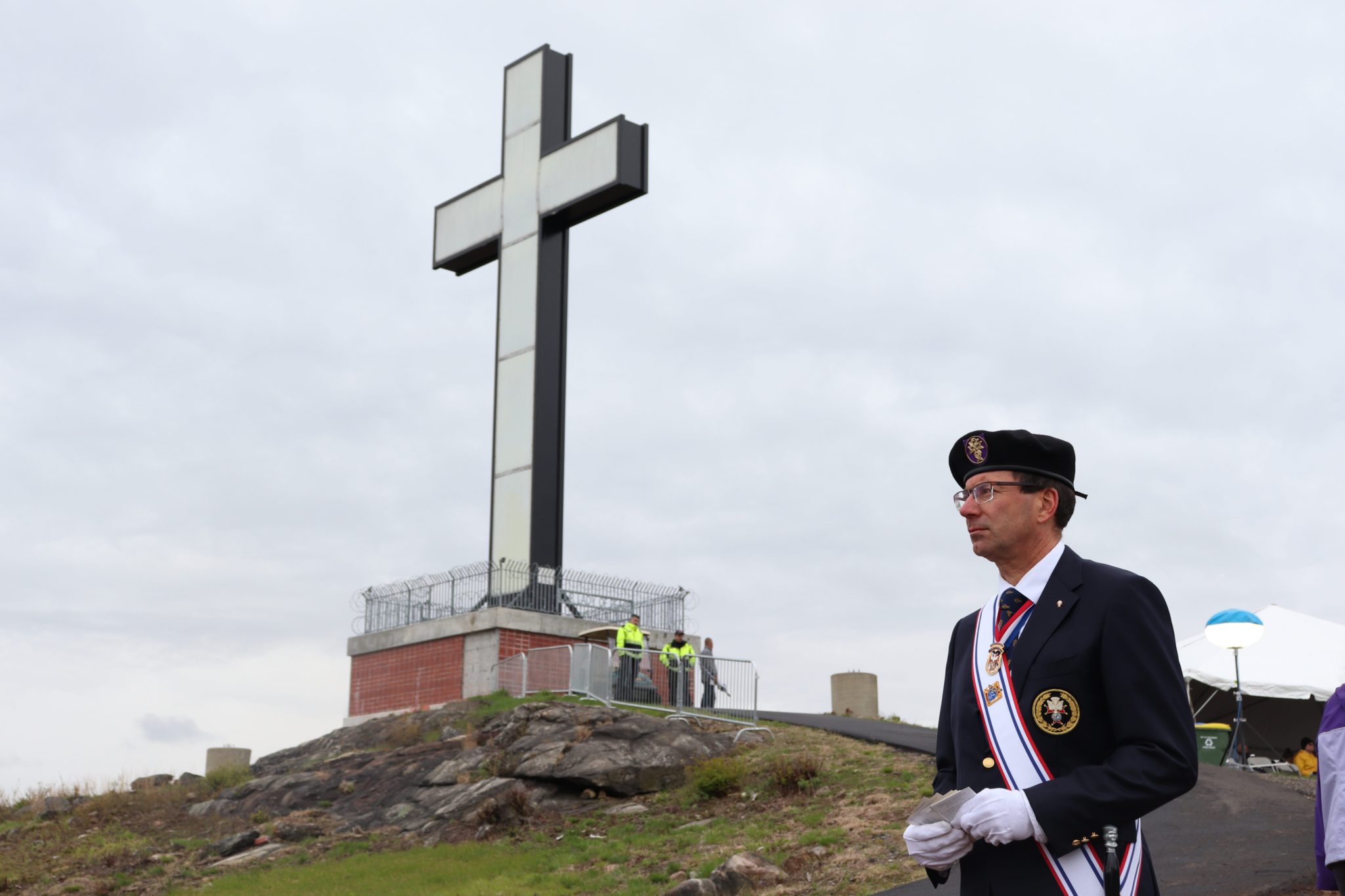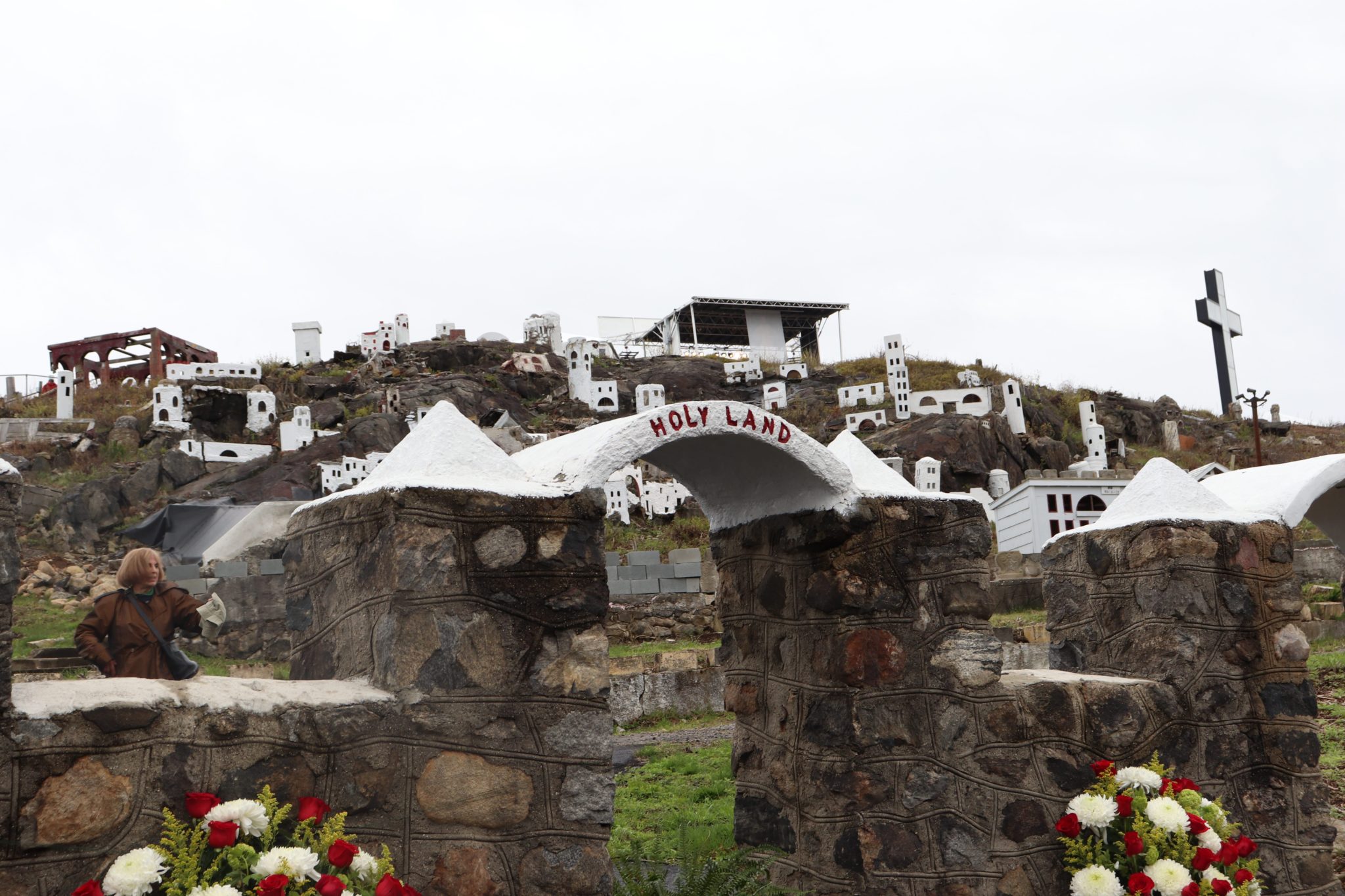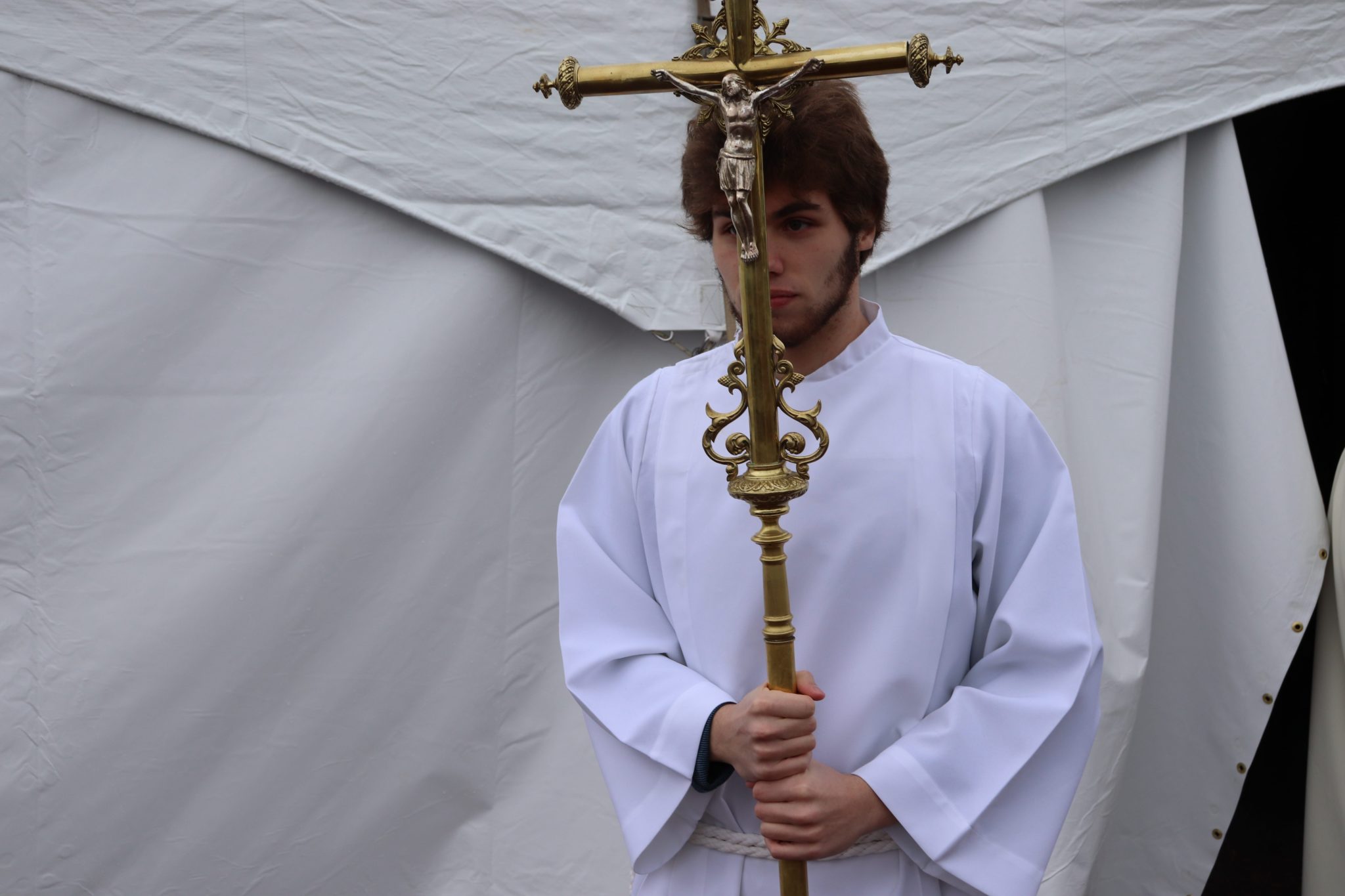Miracle in Progress
A Christian theme park in Waterbury, Connecticut, has been officially closed to the public for 35 years. Can it be saved?

Holy Land USA. hides in plain sight. Although it’s often spoken of as a “Christian theme park,” there’s no flashy “This Way to Holy Land!” sign to direct visitors traveling down the highway. In order to get to the property, which is currently closed to the public, you’ll need to navigate through a maze of steep, winding streets on Pine Hill in Waterbury. Yet when you arrive, you’ll recognize it instantly. Looming over the attraction is a 56-feet LED cross, now a notable fixture of the local skyline. Below it stands three more crosses, smaller and humbler. A nearby plaque indicates that they represent the crosses where Christ and two criminals were hung in the Bible: Calvary in Connecticut.
I visited the roadside attraction in March, when the premises were covered in snow. Miniature recreations of old buildings studded the hilltop, some only coming to my hip in height. I soon identified them as various locations from the Bible, spanning both the Old and New Testaments. Herod’s palace was there; so was the inn from the Nativity story, marked with a “No Vacancy” sign; so was the tomb where Jesus’ body was lain.
An asphalt path on the side of the hill leads to the theme park’s glowing centerpiece, the spiritual equivalent of Disney World’s castle. Nearby stands another spectacle, far more secular in character—an arrangement of massive letters spelling out “Holy Land, U.S.A.,” recalling the famous Hollywood sign. Once, it was grand. If all goes according to plan, it soon will be again.
—

Given no background information, a crowd of Holy Land visitors would likely have the same reaction: It’s striking, all right, but what exactly is it supposed to be?
The answer begins with the story of John Baptist Greco, a Yale law graduate and Roman Catholic. Greco built the park out of his own devotion; the act was “like a prayer,” he said. In 1953, he purchased the land on which Holy Land lies. Then, in 1956, he and his friend Anthony Coviello erected the park’s signature cross, as well as the park’s replicas, then referred to collectively as “Bethlehem Village.” Scrap materials, repurposed appliances, even department store mannequins comprised the miniature cityscape. Holy Land, as it is now known, officially opened in 1958. Although it was partially funded by donations from local churches and Catholic organizations, Greco put much of his own money toward the job.
Holy Land was never Six Flags. There are no roller coasters, no Jesus-themed carnival rides. Yet once upon a time, it attracted thousands of visitors per year — 44,000, according to a 1979 Hartford Courant article. A snack bar catered to hungry Catholics; a gift shop touted souvenirs. Greco never intended to use the park to “sell” religion, though. “We don’t try to convert anybody,” he told the Courant. “We just show them what we believe.”
Indeed, as far as religious attractions go, Holy Land has always been on the humble side. The similarly named Holy Land Experience in Florida, which opened in 2001, charges $50 per guest and features live shows, a rock-climbing wall, and “Trin-i-Tee Mini Golf.” A few states away, Kentucky’s Creation Museum, established by fundamentalist Christians in 2007, explicitly tries to convince visitors that the earth is 6,000 years old (a belief to which, for the record, the Catholic Church does not subscribe). Holy Land doesn’t charge patrons for entry, nor does it have any plaques pushing Catholic doctrines. It is there for all visitors to behold and explore, according to Father James Sullivan.
Sullivan is the rector of the Basilica in Waterbury. He is also a lifelong Waterbury resident who has been involved with Holy Land’s restoration since the 1980s. Holy Land played a prominent role in his life from early childhood. He visited with his aunts, one of whom was a nun.
“Being born in the city and having a business in the city, I’ve always seen the big cross lit up at night,” he says. “And when you’re a child, of course, you think that’s so normal—having a big cross on top of a mountain in your hometown. … But like anything else, you appreciate it more when you get older.”
The cross is one of Sullivan’s favorite aspects of Holy Land. Its prominence in the local skyline, he believes, has inspired many to reflect on their spirituality, if only for a minute. “I know of truck drivers who have said they look forward to seeing Waterbury because it reminds them to say a prayer.”
Jennifer Bremer, the owner of blog Road Trip America, had a similarly pleasant experience when she went to Holy Land with her father as a young girl in the 1970s. “[The buildings] were so small, but a great size for a little kid to peek inside. I don’t know what it is, but there was a special feeling up there. It was calm and peaceful.”
—

Yet the holy side of Holy Land is only part of the story. For every faithful Christian who visits out of devotion, it seems, there’s another person who has made a different kind of pilgrimage to the site. All over the Web, it’s listed as a place of interest for urban explorers. After all, Holy Land has not officially been open to the public since 1984, so to many people, it appears forbidden and eerie. No matter your faith, “abandoned Christian theme park” has a thrilling ring to it.
Damned Connecticut, a blog with headings like “Abandoned,” “Cryptozoology,” “Hauntings,” “Legends,” and “Odd Things,” covered Holy Land in 2009. At the time, it was in “great disrepair,” a mess of debris and litter. The write up noted that the place’s former beauty was clear but obscured.
Atlas Obscura, a website that catalogues strange tourist attractions around the world, was less forgiving. A 2016 post presented the following warning: “Holy Land is far from being the safe haven of replica spirituality that it was … Best bet, stay away: there’s not enough left to justify the trip.”
Adam Harb ’18, who visited Holy Land with some friends in 2014 out of curiosity, agreed. “My expectations were that it would be kind of sad,” he said. “It was revealed to be significantly sad.” He remembers the grounds being covered in trash and filth when he explored them. Walking down the mountain, he felt “unsettled,” eager to get away.
Part of the reason why Holy Land has acquired its “dangerous” reputation is a tragedy that occurred on its premises. In 2010, Chloe Ottman, a 16-year-old girl, visited the site after dark with an acquaintance, Francisco Cruz. He raped and killed her after she rejected his sexual advances. After the incident, the nuns who guarded the property insisted on keeping wanderers out, and the comments section of Damned Connecticut blew up. “Something evil is in that place… [It’s] a shame one had to ruin it for all,” one user said. Another implied supernatural happenings: “As soon as you walk into the woods you can tell that some spirit or force does NOT want you there.”
By the time I visited its premises, the hubbub had died down. Many Yale students I spoke with beforehand were familiar with the crime that happened there, but I heard no rumors of hauntings. Circling the hill, I felt safe, unburdened by phantoms. Nor did I notice an absurd amount of garbage. Yet it was clear that the park had seen better days. The lettering on the Bethlehem inn was chipping; the fence intended to keep ne’er-do-wells away from the Calvary crosses was broken. The graffiti I saw consisted of simple artist tags, and the words “Julia’s ass” sprayed onto a nondescript structure in bold black paint.
—

Proponents of Holy Land have not turned a blind eye to its often sorry state over the years. Instead, they are trying to renew it through grassroots campaigns.
The first round of restoration attempts started in 1985, just a year after the theme park’s official closing. An April 1985 Hartford Courant article explained that the new, reimagined Holy Land would include updates to the replicas of Biblical sites on the hill, as well as a visitor’s center. Sister Angela Bulla, then president of Holy Land’s Board of Directors, aimed to raise 1 million dollars.” Yet Father Sullivan, who was involved with the efforts, said that the renovations “never really got off the ground,” although he and other interested parties did meet to discuss them.
Now, Holy Land’s new chapter has begun — largely due to Sullivan’s advocacy in 2016, which put it back in the public eye. At the time, Sullivan was working at the Church of the Assumption in Ansonia, Connecticut.
“In the Bible, there’s this story of what’s called the transfiguration. Jesus, Peter, James and John climbed to the top of this mountain at night,” he said. In the nearby town of Beacon Falls, he noticed a mountain that vaguely resembled the mountain where the Transfiguration is said to have taken place. He found himself thinking, “Wouldn’t it be nice to have a Mass on top of that mountain?” Thus, he began planning a Beacon Falls hilltop Mass. His hopes were fulfilled: the celebration was a success, and Waterbury’s Catholic community clamored for more.
“As they say, ‘Go big or go home,'” he said. “So I figured, “Let’s go bigger,” and I thought, ‘What venue would that be? Well, how about Holy Land, in Waterbury?'”
On the day of that Mass — August 18, 2018 — rain poured down. Still, 1,100 guests showed up. The day was such a success that another “hilltop Mass” will take place on April 28 — and this time, Sullivan expects thousands.
Sullivan hopes that it will not only be a liturgy but an opportunity for community fellowship. His sentiments point to the importance of Holy Land as not only a religious site, but a local landmark. As a fixture since the 1950s, Holy Land has a long history with the town, and its renovation efforts have received no shortage of support.
Waterbury is majority Catholic and most of the people who have reached out to extend their support for Holy Land are Catholic, too, Sullivan says. Yet people from all kinds of religious backgrounds have stepped in to volunteer with renovation efforts or simply express their appreciation for Holy Land — people from “other Christian churches,” as well as “people of no faith who just have a love for the mountain,” he said. The theme park also has a following among creative types who appreciate it from an aesthetic perspective, considering it environmental folk art.
Recently, Sullivan and other volunteers removed trees and boulders from the site. Larger-scale improvements have occurred, too. When the road to the top of the mountain was damaged, a construction company donated its labor to repair it; a manufacturer donated the tar.
These developments, which will prepare Holy Land to open its doors this spring, have left Sullivan feeling optimistic. “I feel a miracle is going to happen on that mountain—and I think it’s a question of when, not if.”








